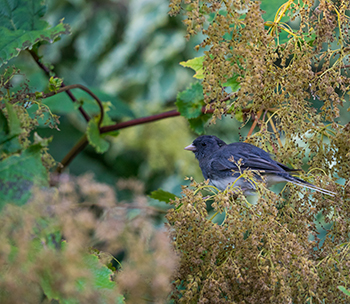Creating a bird-friendly backyard habitat can be as low-maintenance as installing nesting boxes, bird feeders and a simple birdbath, or as involved as an entire backyard overhaul, complete with reducing the area of lawn, installing native plants and removing invasive plants from your property.
One of the more quickly rewarding options—for you and for the birds—is to plant a bird-friendly garden. First, though, it’s important (but fun!) to learn different birds’ preferences so you can figure out which plants you’d like to grow. Obviously, different plants provide for birds differently, depending on whether they’re grown for their seeds, fruit, nuts, nectar or as a hosting station for hungry insects (i.e. bird food).
An ideal garden would include a wide range of plants, including flower-, berry-, seed- and nut-producers. Seed-lovers like goldfinches, sparrows, nuthatches and chickadees will feast on seed heads produced by sunflowers, asters, echinacea, zinnia, marigolds, goldenrod and black-eyed Susans. Nectar-lovers like hummingbirds, meanwhile, will flock (no pun intended…) to a landscape of bee balms, geraniums, delphiniums and salvias.
 But what flowers produce is just as important as when they produce it. For a truly holistic, bird-friendly habitat, having plants that flower or fruit throughout the year is a bonus. Think blueberries, blackberries and raspberries for summer fruits; hawthorn and American beauty berry in the fall; holly and rose for winter; and cherry, butterfly weed and redbud for the spring.
But what flowers produce is just as important as when they produce it. For a truly holistic, bird-friendly habitat, having plants that flower or fruit throughout the year is a bonus. Think blueberries, blackberries and raspberries for summer fruits; hawthorn and American beauty berry in the fall; holly and rose for winter; and cherry, butterfly weed and redbud for the spring.
Besides food and water, birds also need shelter. Luckily for us in The Pine Tree State, pines are a perfect year-round option (and, bonus, the chickadees love the seeds). Junipers, too, are a good choice, offering shelter and a place for ground-feeders like juncos to feast on unsuspecting insects while titmice and waxwings feast on berries later in the season.
If a habitat overhaul is your dream, consider planning your landscape in layers for ultimate bird-friendliness—upper layers can consist of trees; lower layers of ground covers, low-lying perennials and annuals; and then the in-between can be filled with perennials, annuals, grasses and fruit-bearing shrubs.
Creating a habitat can be certainly be a season-long or a multi-year project; the good news, though, is that you can begin anytime for immediate results. If you want some expert guidance, however, maybe consider attending our upcoming collaboration with Hog Island Audubon Camp, “Creating Bird-Friendly Habitats,” August 18-21, 2019, where you can join noted author Doug Tallamy to learn about restoring natural relationships between native plants and insects. Then Audubon’s Dr. Stephen Kress will discuss the co-evolution of native plants and native birds and provide tips for creating bird-friendly habitats mimicking native plant communities.
Other instructors will include our own Plant Curator, Andy Brand, who will share his gardening knowledge about native plants and wildlife ecologist Deb Perkins, who will provide tips on enhancing larger properties such as forests and meadows. There are even options for obtaining funding from government programs for attracting birds to private properties. To learn more and to register, visit Hog Island Audubon: hogisland.audubon.org/programs/creating-bird-friendly-habitats.